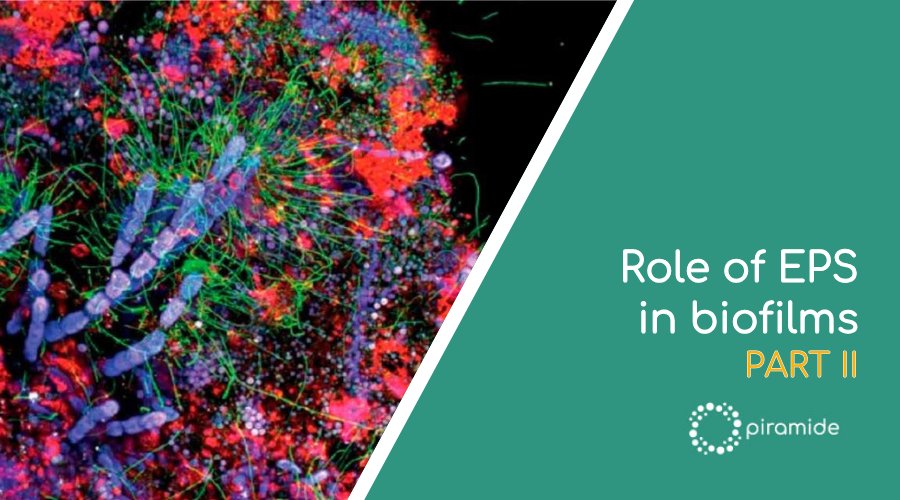Role of eDNA (extracellular DNA)
Extracellular nucleic acids deserve specific attention as they have been the most neglected and underestimated component of EPS. However, they turn out to be of surprising and complex significance. Nucleic acids have been found in the EPS matrix before, but they were usually interpreted as residues of lysed cells (Catlin et al., 1956), which is why little initial attention was paid to eDNA. In 2001, the publication by Whitchurch et al. referred for the first time to extracellular DNA (eDNA) as material required for the formation of Pseudomonas aeruginosa biofilms and, thus, had a function. In another publication, Villain et al. showed that eDNA is important for adhesion during Bacillus cereus cell attachment and that for several species eDNA is essential during the early stages of biofilm formation. Other studies have suggested a structural function of eDNA in the formation of thick films and biofilms. It is likely that these effects are mediated by the physical properties of eDNA, which increases the hydrophobicity of the cell surface and this also increases adhesion to hydrophobic surfaces. This is reflected in studies in which eDNA-free biofilms are more easily removed when exposed to surfactant stress.
Relationship between EPS properties and shear stress
Several studies have shown that the hydrodynamic conditions to which the matrix is subjected can contribute to the wide variety of biofilm morphologies. In response to shear stress, for example, the matrix initially exhibited the properties of an elastic body, which turned into a viscoelastic liquid when a certain breaking point was passed. Under stagnant or low-flow conditions, fewer cohesive biofilms are observed, whereas thinner and stronger biofilms emerge under high-flow conditions. Biofilms can respond to shear stress by forming ripples and even rolling along a surface. Shear stress also influences the composition, dynamics and diversity of biofilms. High shear stress would appear to decrease the diversity of the biofilm and the dynamics of the populations forming it. Shear stress would therefore slow down biofilm maturation and tend to maintain a ‘young’ biofilm.
Movement dynamics within the EPS
When thinking of a biofilm, it is easy to imagine cells immobilised within the amorphous matrix they have produced. However, it has been observed that not all cells in the matrix are immobilised but some of them can move. For example, Bacillus subtilis migrates within it, forming multicellular structures. In this case, migration depends on the synergistic interaction of two types of cells: surfactin-producing cells and matrix-producing cells. The surfactin-producing cells facilitate migration by reducing the friction between the cells and their substrate, thus allowing the matrix-producing cells to organise themselves into bundles that form filamentous rings at the edges of the colony’. This is a clear example of collective swarm-like behaviour, where movement is driven by the flagella of B. subtilis. In a study by Houry et al. in 2012, it was discovered that Bacillus thuringensis in the planktonic state, propelled by flagella, was able to tunnel deep within a biofilm. These cells, termed ‘swimmers’, create transient pores that increase the mass transfer of other cells within the biofilm. The invasion of the biofilm by swimmers can improve the fitness of the biofilm by creating channels, increasing the flow of nutrients into the matrix or the expulsion of unwanted substances. Other authors have also described mobility as a competitive strategy: swimmers can exacerbate the killing of biofilm bacteria by facilitating the penetration of toxic substances from the environment or by facilitating their exit from the matrix itself.
From training to release
The matrix is clearly one of the distinguishing features of the biofilm and is largely responsible for the cohesion of the cells within the biofilm. At the end of the biofilm lifecycle, bacteria can return to the planktonic phase through passive processes, e.g. flaking or erosion, and active processes, dispersal. Dispersal has been shown to be genetically controlled in response to a series of signals and stimuli such that the bacteria can control the transition from a sessile to a free-living lifestyle. Active dispersal requires the bacteria to break out of the matrix, which consists of various proteins, polysaccharides and extracellular DNA, etc. Some bacteria, such as Pseudomonas putida, use large amyloid-like proteins to anchor themselves to surfaces and begin to synthesise proteases that can specifically cleave certain proteins in the matrix, promoting cell release. Similarly, some bacteria encode for enzymes that degrade polysaccharides, such as alginate lyase, chitinase or dispersin, which are produced during the dispersion phase to degrade these matrix polymers. There is also strong evidence that bacteria encode nuclease to degrade the third major matrix biomolecule, eDNA. These examples represent only part of the wide range of mechanisms by which microorganisms can break out of the matrix through the production of specific enzymes by the microorganisms themselves. However, it is also possible that the activity of such enzymes is not limited to dispersion alone, but may also be important in remodelling the biofilm matrix as it matures or adapts to changing environmental conditions, such as shear forces.
Eliminating EPS with enzymes
The role of the matrix described so far highlights how strategic its complete elimination is in order to ensure effective biofilm removal. The use of enzymes capable of specifically hydrolysing this matrix represents a valid system for its removal, but only if this approach also takes into account its complexity. This is why Piramide, thanks to the constant work of Realco’s R&D, is able to provide with Biorem® an enzymatic solution specifically designed for:
- Contain enzymes belonging to more than one enzyme class, and therefore aimed at different molecular targets
- Contain enzymes with high substrate specificity
- Contain enzymes with high activity
These aspects are very important to consider whenever evaluating an enzymatic approach for the removal of biofilm, or rather its amorphous matrix. Products with poor enzyme classes, low specificity and low activity may lead to poor results. Bibliographic references
- Geesey, G.G. Microbial exopolymers: Ecological and economic considerations. ASM News 1982, 48, 9–14.
- Flemming, H.-C.; Wingender, J.; Kjelleberg, S.; Steinberg, P.; Rice, S.; Szewzyk, U. Biofilms: An emergent form of microbial life. Nat. Rev. Microbiol. 2016, 14, 563–575.
- Sutherland, I.W. Bacterial exopolysaccharides. Adv. Microb. Physiol. 1972, 8, 143–213.
- Flemming, H.-C.; Neu, T.R.; Wingender, J. The Perfect Slime: Microbial Extracellular Polymeric Substances (EPS); IWA publishing: London, UK, 2016
- Neu, T.R.; Lawrence, J.R. Extracellular polymeric substances in microbial biofilms. In Microbial Glycobiology:
- Structures, Relevance and Applications; Moran, A., Brenan, P., Holst, O., von Itzstein, M., Eds.; Elsevier: San Diego, CA, USA, 2009; pp. 735–758.
- Houry, A.; Gohar, M.; Deschamps, J.; Tischenko, E.; Aymerich, S.; Gruss, A.; Briandet, R. Bacterial swimmers that infiltrate and take over the biofilm matrix. Proc. Natl. Acad. Sci. USA 2012, 109, 13088–13093.
- Hans-Curt Flemming, EPS—Then and Now. Microrganism, 2016



